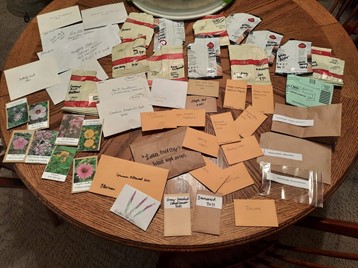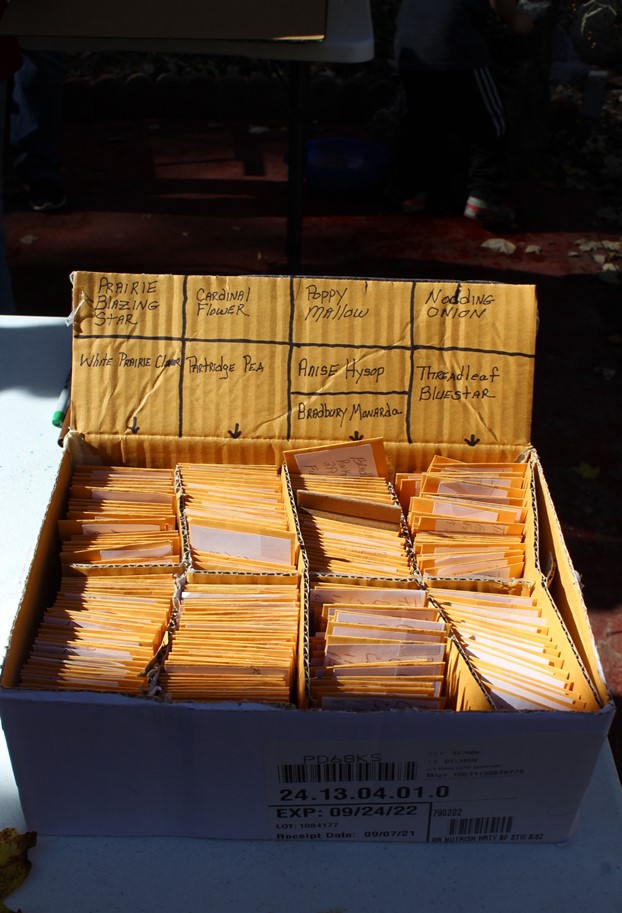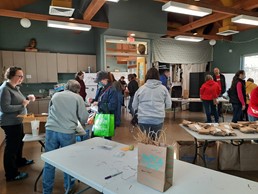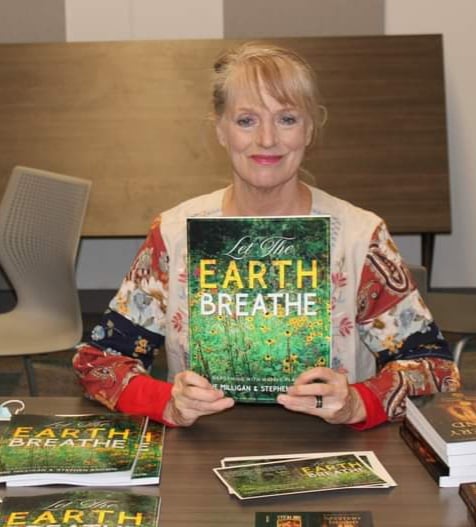
By Anne Milligan
When I was asked to write a summary of our Kentucky native plants and seeds swaps in Louisville, Kentucky, I was excited to share, but I also felt a bit of trepidation. How does one adequately describe a project that seems to have tapped a societal nerve, so to speak, and taken on a life of its own over the past few years? With three swaps under our belts, I want to share how this project began, and just a hint of how it is evolving, as more people come on board. I’m hopeful that our experience will help others establish swaps in their own communities.
2010
Stephen Brown and I moved to Louisville after having lived in the middle of the woods for three years in “employee housing” at the Abraham Lincoln Birthplace National Historical Park in Hodgenville, Kentucky. We loved the woods so much that we decided to look for a house surrounded by trees. We moved to a property abutting some woodland acreage and began our 12-year creation of a Kentucky native plants sanctuary.
2010-2019
That first decade involved a whole lot of physical labor on our part, creating a series of connected rain gardens flowing gradually downhill across our back, front and side yards. These gardens (plus some drier areas) are now populated with over 80 Kentucky native flowers, ferns, shrubs, and trees.
From the very beginning, we have carefully documented the project in photos and daily journal logs at Let the Earth Breathe, Inc. Please refer to our 2021 book Let the Earth Breathe for a more detailed narration of our home project, what we’ve learned so far, and some delightful surprises we encountered along the way.
2019
When we had established about 60 varieties of native species, we realized that we were running out of room to expand our “yarden” and decided to form a Facebook native seed swap group to share some of the abundance. We had a grand total of six people at our very first swap meeting in November of 2019. We were small but mighty though, because the Facebook group began to expand dramatically in a very short time after this swap.
2020
As you probably know, the Covid pandemic forced many people into quarantine, which catapulted many of us into home landscaping projects. Our annual swap was cancelled. We then divided the original group into five regional “socially distanced,” mini-swaps that covered most of the Louisville area. Besides our own swap in the southeast region of Louisville, four leaders stepped up to host their own regional swaps.
A lot of seeds were exchanged by mail and porch pick-ups. Our primary inspiration for creating home native plants sanctuaries (or “yardens”) was, and still is, Dr. Douglas Tallamy’s book Bringing Nature Home. Another very helpful book for beginning native gardeners is Wildflowers and Ferns of Kentucky by the late Dr. Thomas Barnes.
2021

On November 6, 2021, regional swaps took place again at the hosts’ homes. I think everyone will agree that the regional swaps are here to stay, because smaller communities are developing in local neighborhoods within these regional swaps. Together, many of us are gaining more courage to remove those tidy, but unsustainable, grassy lawns and replace them with landscaped native plants, shrubs, and trees.

November 27, 2021
Three weeks after the regional swaps, our annual “citywide” swap took place at the Louisville Nature Center. We held this citywide swap to further distribute the extra seeds, plants, and tree saplings that were left over from the regional swaps. As I posted in our Facebook groups after this citywide swap, “I have never seen such a marvelously biodiverse collection of native seeds, plants, and trees in my entire life.” The people were equally diverse by age, gender, culture, and even in the unique ways we packaged our seeds.
Labeling the seed packages with name, bloom time, and year collected, was stressed as very important in the weeks preceding the swaps. Some of the species were even brought over the river from New Albany, Indiana. From 1:00-4:00 PM, a steady, but never overwhelming flow of people swapped native seeds and plants.
We organized the seeds by placing tables in a large semi-circle according to the bloom times of individual seeds and plants, beginning with early spring ephemerals, all the way around to late summer and fall. We had to add extra tables to handle the generosity and abundance.
All of the regional hosts were present to greet our visitors, many of whom were surprised that all of these seed packages, plants, native grasses, and trees were free. And yet that is part of the magic of what I feel will become an annual event. My vision is that our swaps will always, first and foremost, be neighborly and welcoming, without the trappings and competition of buying and selling.
I hope that, as you read this, you will consider forming your own swap group, and hold fast to a primary rule, which is to share only species native to your region. If you are a Facebook group administrator, please know that a successful swap group also requires that you keep people engaged throughout the year, sharing books, articles, and so on and that you clarify again and again that our pollinators depend on native species for their very survival, and thus, human survival on the planet.
Most of all, keep it fun. As Margaret Shea, of Dropseed Native Plants Nursery, once told us, “It’s fun to put things in the ground.” And it really is.

Photo: Deany Collard.
Final Notes
On a personal level, I am happy to say that these swaps have given many participants a much-needed social connection with people who care about our planet and love gardening. We need these connections, sometimes more than we need extra money or material goods. Making positive social connections around native-plant gardening keeps us well and helps strengthen our resolve to free ourselves of our addiction to non-native grassy lawn care and help restore our planet to its natural goodness.
Lastly, please consider donating to the non-profit foundation created by Anne Milligan and Stephen Brown called “Let the Earth Breathe, Inc.” to help fund other small native species projects around our area. You can do so by visiting Let the Earth Breathe, Inc..
Happy planting!

Anne Milligan is an artist, singer/musician, and landscape designer. She lives in Louisville, KY with her husband, author and historian Stephen A. Brown.
